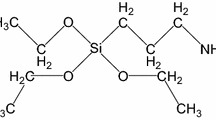Abstract
The influence of peroxide bleaching and slack-mercerization on the amount of acidic groups in regenerated fibres (viscose, modal and lyocell) were studied. Conductometric titration was used to determine the total content of acidic carboxylic groups. Polyelectrolyte titration was used for surface and total charge determination, and to obtain information about the charge distribution and accessibilities of charged groups. Changes in fibre crystallinity to pre-treatment processes were characterized using iodine sorption (Schwertassek method) and correlated to treatments and the amount of carboxylic groups. For all three types of fibres the amount of accessible carboxyl groups was lowered by an increase in the degree of crystallinity. Bleaching with hydrogen peroxide causes some oxidative cellulose damage and, therefore, a larger amount of carboxyl groups (presumably formed at the end of cellulose chains). Slack-mercerization did not significantly change the total amount of acidic groups in the fibres, but their accessibility to cationic polyelectrolytes, in particular to polymers with high molecular weight was substantially lowered.



Similar content being viewed by others
References
Alén R (2000) Basic chemistry of wood delignification. In Stenius P (ed) Forest products chemistry. Fapet Oy, Helsinki, Finland, pp 59–107
Barzyk D, Page D, Ragauskas AJ (1997) Acidic group topochemistry and fiber-to fiber specific bond strength. J Pulp Pap Sci 23:520
Bredereck K, Gruber M, Otterbach A, Schulz F (1996) Die Hydrogelstruktur von Cellulosefasern und ihre Bedeutung für Fasereingenschaften und Textilveredlung. Textilveredlung 31(9/10):194
Blackwell J, Kolpak FJ, Gardner KH (1977) Structures of native and regenerated celluloses. In Arthur JC, Jr (ed) Cellulose chemistry and technology, ACS Symposium Series, American Chemical Society, Washington, DC, USA, pp 42–55
Fras L, Laine J, Stenius P, Stana-Kleinschek K, Ribitsch V, Dolecek V (2004) Determination of dissociable groups in natural and regenerated cellulose fibers by different titration methods. J Appl Polym Sci 92:3186
Fras-Zemljič L, Stenius P, Laine J, Stana-Kleinschek K (2006) The effect of adsorbed carboxymethyl cellulose on the cotton fibre adsorption capacity for surfactant. Cellulose 13:655
Hessler LE, Power RE (1954) The use of iodine adsorption as a measure of cellulose fibre crystallinity. Textile Res J 24:822
Hunter RJ (1981) Zeta potential in colloid science. Academic Press
Jacobasch HJ, Bauösk G, Schurz J (1985) Problems and results of zeta-potential measurements on fibers. Colloid Polym Sci 263/3:24
Katz S, Beatson RP, Scallan AM (1984) The determination of strong and weak acidic groups in sulfite pulps. Svensk Papperst 87:R48
Klemm D, Philipp B, Heinze T (1998) Comprehensive cellulose chemistry. Wiley-VCH Verlag, Winheim, Germany, pp 9–32
Kreze T, Strnad S, Stana-Kleinschek K, Ribitsch V (2001) Influence of aqueous medium on mechanical properties of conventional and new environmentally friendly regenerated cellulose fibres. Mater Res Innovat 4:107
Kreze T, Jeler S, Strnad S (2002) Correlation between structure characteristics and adsorption properties of regenerated cellulose fibres. Mater Res Innovat 5:277
Krässig HA (1984) Struktur und reaktivität von Cellulosafasern. Das Papier 38:571
Krässig HA (1992) Cellulose, structure, accessibility and reactivity. Gordon & Breach, New York
Laine J, Lövgren L, Stenius P, Sjöberg S (1994) Potentiometric titration of unbleached kraft cellulose fibre surfaces. Colloids Surf A Phys Chem Eng Asp 88:277
Laine J, Buchert J, Viikari L, Stenius P (1996) Characterization of unbleached kraft pulps by enzymatic treatment, potentiometric titration and polyelectrolyte adsorption. Holzforschung 50:208
Laine J, Stenius P (1997) Effect of charge on the fibre and paper properties of bleached industrial kraft pulps. Pap Puu 79:257
Lewin M, Roldan LG (1971) The effect of liquid anhydrous ammonia on the structure and morphology of cotton cellulose. J Polym Sci C 36:213
Persin Z (2001) Uporaba tenziometrije za spremljanje sorpcijskih lastnosti obdelanih celuloznih vlaken, Master Degree, University of Maribor, Maribor, Slovenia
Persin Z (2004) Strukturne in sorpcijske lastnosti obdelanih regeneriranih celuloznih vlaken, Dissertation, University of Maribor, Maribor, Slovenia
Persin Z, Stana-Kleinschek K, Sfiligoj-Smole M, Kreže T, Ribitsch V (2004) Determining the surface free energy of cellulose materials with the powder contact angle method. Textile Res J 74:55
Ribitsch V, Stana-Kleinschek K, Kreže T, Strnad S (2001) The significance of surface charge and structure on the accessibility of cellulose fibres. Macromol Mater Eng 286:648
Schurz J, Jánosi A (1982) Röntgenkleinwinkel-Studien über das Hohlraumsystem von verschiedenen Celluloseproben. Holzforschung 36:307
Schurz J, Lenz J (1994) Investigations on the structure of regenerated cellulose fibres. Macromol Symp 83:273
Schwertassek K (1931) Über eine zahlenmäßige Bestimmung des Mercerisiergrades. Melliand Textilberichte 12:457
Schwertassek K (1960) Der nachwies von Bindungen zwischen Farbstoffen und Cellulose mit der Jodsorptionsmethode. Faserforschung und Textiltechnik 11:159
Schwertassek K (1961) 30 Jahre Strukturstudien an Cellulosefasern mittels der Jodsorption. Rückblick und Ausblick. Faserforrschung und Textiltechnik 12:369
Sfiligoj I, Smole M, Peršin Z, Kreže T, Stana Kleinschek K, Ribitsch V, Neumayer S (2003) X-ray study of pre-treated regenerated cellulose fibres. Mater Res Innovat 7:275
Sjöström E, Enström B (1966) A method for the separate determination of sulpho and carboxyl groups in sulphite pulps. Svensk Papperst 69:R55
Sjöström E (1992) Wood chemistry. Fundamentals and applications, 2 edn. Academic Press, San Diego, 293 p
Stana-Kleinschek K, Ribitsch V, Kreže T, Fras L (2002) Determination of the adsorption character of cellulose fibres using surface tension and surface charge. Mater Res Innovat 6:13
Acknowledgments
We thank the Finnish Centre for International Mobility (CIMO), which provided financial support for this work and Prof. Janne Laine from Laboratory of Forest Products Chemistry for scientific discussion. We also thank Katja Routanen and Ritva Kivelä, Laboratory of Forest Products Chemistry, as well as Tanja Kos and Vida Žižek, Laboratory for Characterization and Processing of Polymers, for their skilful technical assistance.
Author information
Authors and Affiliations
Corresponding author
Additional information
Lidija Fras Zemljič, Zdenka Peršin, and Karin Stana Kleinschek are the members of the European Polysaccharide Network of Excellence (EPNOE).
Rights and permissions
About this article
Cite this article
Zemljič, L.F., Peršin, Z., Stenius, P. et al. Carboxyl groups in pre-treated regenerated cellulose fibres. Cellulose 15, 681–690 (2008). https://doi.org/10.1007/s10570-008-9216-6
Received:
Accepted:
Published:
Issue Date:
DOI: https://doi.org/10.1007/s10570-008-9216-6




